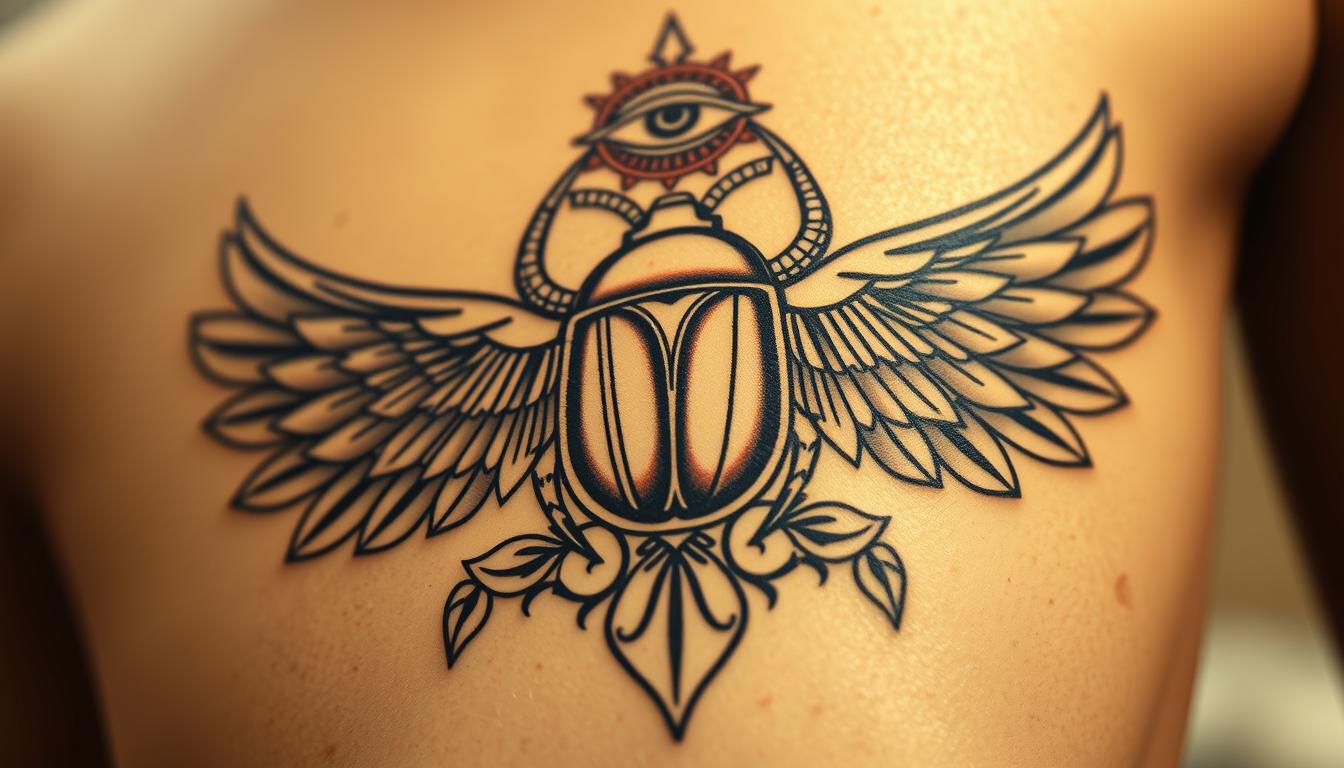
Egyptian tattoos embody a deep spiritual significance, carrying the legacy of an ancient world into the present. The allure of the mysterious Sphinx or the majestic Pyramids calls to many, with each line and curve a testament to a civilization that has captivated humanity for millennia.
These designs aren’t just decorative; they carry profound cultural, religious, and protective meanings. From the Eye of Horus to the Ankh symbol, Egyptian tattoo designs offer a rich visual language that connects wearers to ancient wisdom.
Key Takeaways
- Egyptian-inspired tattoos represent one of the oldest tattooing traditions.
- These tattoos carry cultural, religious, and protective meanings.
- Popular designs include the Eye of Horus and the Ankh symbol.
- Egyptian tattoos offer a rich visual language connecting wearers to ancient wisdom.
- Modern enthusiasts are drawn to Egyptian imagery for its aesthetic and symbolic depth.
The Rich History of Egyptian Tattoos
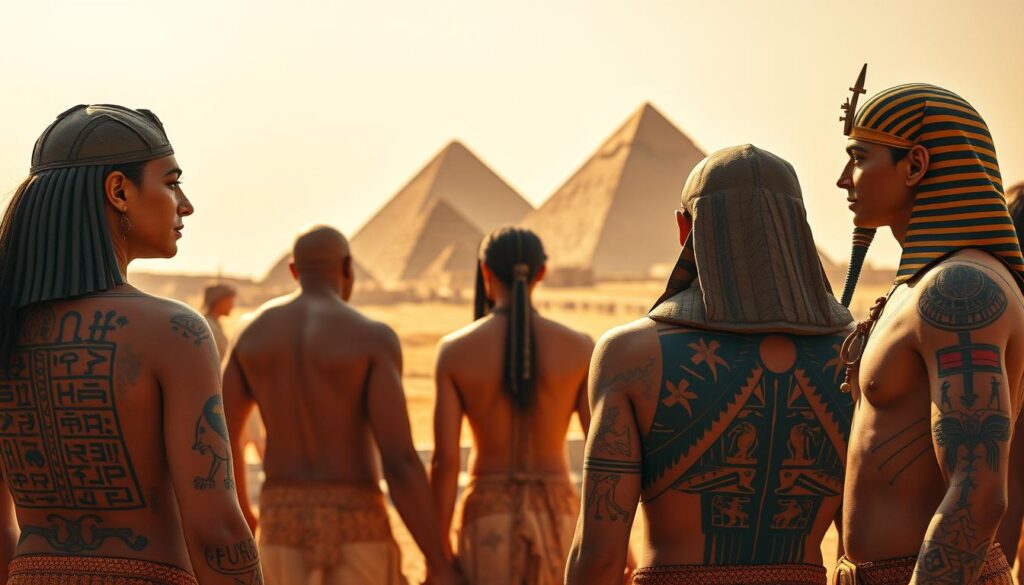
The history of Egyptian tattoos is a fascinating tale that spans thousands of years, deeply rooted in ancient traditions. Tattoos have been a part of human culture for millennia, with various civilizations contributing to the art form. In ancient Egypt, tattooing was practiced as early as the Middle Kingdom period.
Ancient Origins and Archaeological Evidence
Archaeological findings have revealed that tattooing in ancient Egypt dates back to at least the Middle Kingdom period (circa 2000-1700 BCE). This makes Egyptian tattooing one of the oldest documented tattooing traditions. Tattoos were primarily found on women’s bodies, particularly among priestesses and high-status women, challenging earlier assumptions that associated tattoos exclusively with dancers or women of “dubious status.”
The discovery of tattooed mummies, such as the Priestess of Hathor Amunet, provides concrete evidence of the practice and its connection to religious roles. Archaeological evidence from sites like Deir el-Medina and Deir el-Bahari has revealed mummies with extensive tattoos, indicating that the practice was more widespread than initially thought.
Tools and Techniques Used in Ancient Egypt
Ancient Egyptian tattooing tools were relatively simple yet effective, consisting of sharp bronze needles that could create patterns of dots and lines when bound together. The pigments used were typically dark blue or black, derived from natural substances, and carried symbolic meanings related to fertility, protection, and rebirth.
The tattooing process was likely performed by experienced older women who understood both the technical aspects and the profound symbolic significance of the designs. The techniques used in ancient Egypt have influenced tattooing traditions throughout time, with some contemporary artists drawing inspiration from these ancient methods.
Symbolism and Meaning Behind Egyptian Tattoos
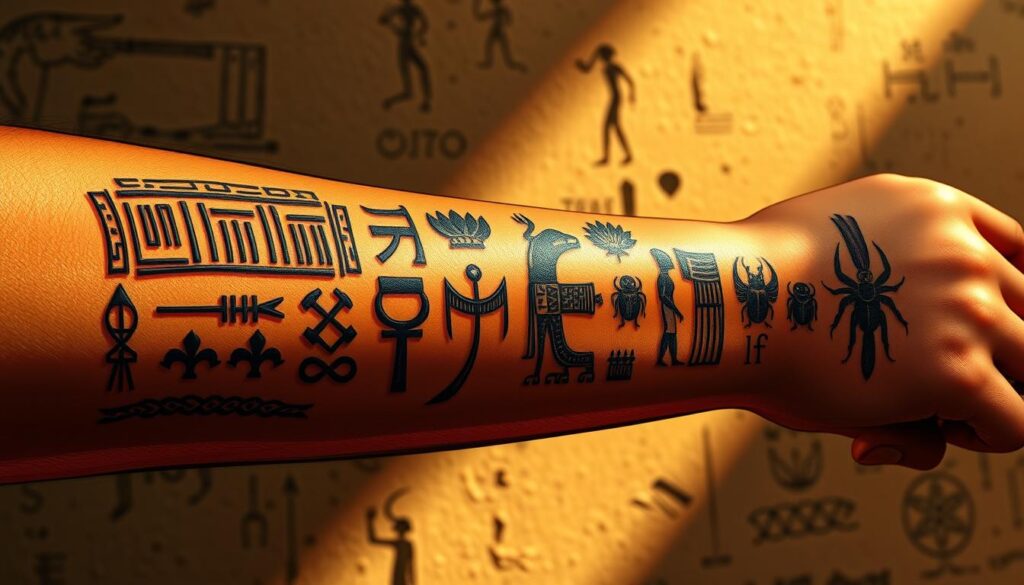
Ancient Egyptian tattoos were more than just decorative; they carried significant religious and spiritual meaning. These tattoos were a permanent form of expression, conveying a range of messages from devotion to divine protection.
Religious and Spiritual Significance
Egyptian tattoos were deeply rooted in the religious and spiritual practices of the time. They often served as permanent marks of devotion to specific deities or as symbols of divine protection. The use of religious motifs in tattoos was common, with designs that included gods and goddesses revered in ancient Egyptian religion.
For instance, the Copts, Egyptian Christians, would tattoo crosses on their wrists or between their thumb and forefinger. This practice, dating back to the eighth century, symbolized their faith and ensured burial in consecrated ground. Similarly, Muslim Egyptians used tattoos to signify pilgrimages to holy sites like Mecca.
Protection and Magical Properties
Many Egyptian tattoos were designed with protective purposes in mind. Symbols like the Eye of Horus were believed to ward off evil and provide healing properties to the wearer. The protective nature of these tattoos was especially significant for women, who would often wear tattoos as a form of protection during pregnancy and childbirth.
The god Bes, frequently tattooed on women’s thighs, was particularly associated with protection during childbirth. This strategic placement of tattoos on the body was believed to maximize their magical efficacy, creating a symbolic shield between the mother, child, and harmful forces.
| Symbol | Meaning | Significance |
|---|---|---|
| Eye of Horus | Protection and Healing | Warded off evil, provided healing |
| Cross | Faith and Devotion | Signified Christian faith, ensured consecrated burial |
| Bes | Protection during Childbirth | Protected women during childbirth |
Status and Identity Markers
In addition to their religious and protective functions, tattoos in ancient Egypt also served as status and identity markers. Certain tattoo designs indicated a person’s role in religious ceremonies or their position within social hierarchies. The permanence of tattoos made them powerful symbols of one’s lifelong commitment to specific beliefs, deities, or social roles.
Thus, Egyptian tattoos were not only decorative but carried complex layers of meaning that reflected the wearer’s status, beliefs, and experiences.
Popular Egyptian Tattoo Designs
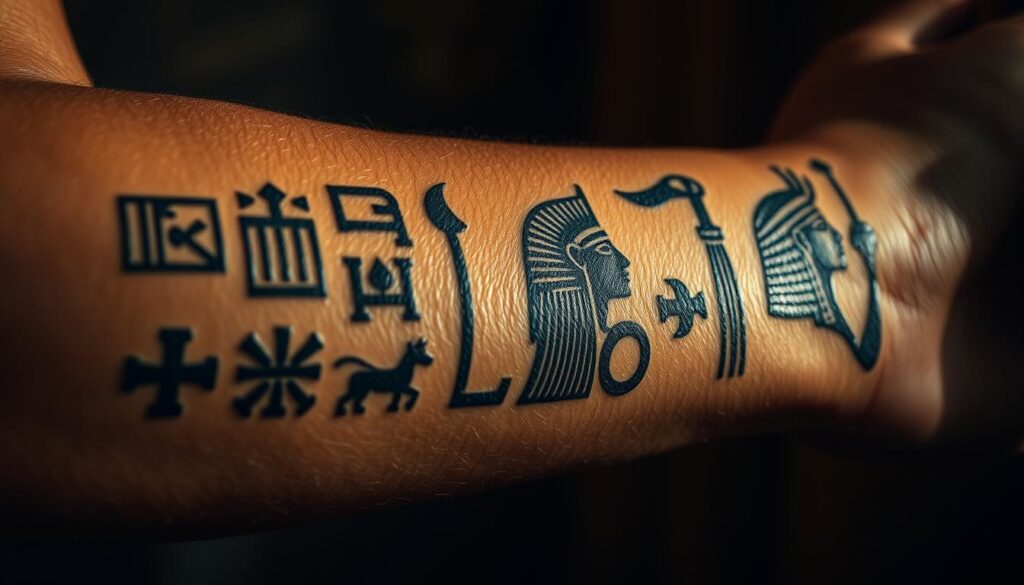
For those drawn to the mystique of ancient Egypt, tattoos inspired by this civilization offer a powerful means of self-expression. Egyptian mythology is rich in symbols and figures that have become popular motifs in tattoo art, each carrying its own unique significance and story.
The Eye of Horus: Protection and Healing
The Eye of Horus stands as one of the most captivating and mystic symbols emerging from ancient Egypt, representing protection, healing, and restoration. This powerful symbol tells the story of Horus’s battle with Set, where his eye was damaged and later healed, making it a perfect tattoo choice for those who have overcome personal challenges or seek protection.
The Ankh: Symbol of Eternal Life
The Ankh, known as the “key of life” or “cross of life,” represents eternal life and regeneration, making it a meaningful tattoo for those seeking symbols of vitality, rebirth, or spiritual awakening. This ancient Egyptian symbol is a potent reminder of the cycle of life and death.
Egyptian Gods and Goddesses
Egyptian gods and goddesses provide rich material for detailed tattoo designs, with figures like Anubis (guide to the afterlife), Isis (motherhood and magic), and Ra (the sun god) each carrying unique symbolic meanings. These deities are not only significant in Egyptian mythology but also offer versatile options for those looking to incorporate their stories into tattoos.
Scarab Beetles and Other Sacred Creatures
The scarab beetle, representing transformation and rebirth, makes for a distinctive tattoo design that symbolizes the daily renewal of life as the sun rises. Other sacred creatures in Egyptian mythology, such as the falcon (associated with Horus), cats (linked to Bastet), and jackals (connected to Anubis), offer versatile design options with deep symbolic roots.
These symbols and figures from Egyptian mythology not only provide a wealth of inspiration for egyptian tattoos but also allow for a blend of traditional and contemporary design elements, making each tattoo a unique expression of personal identity and cultural heritage.
Egyptian Hieroglyphics as Tattoo Art
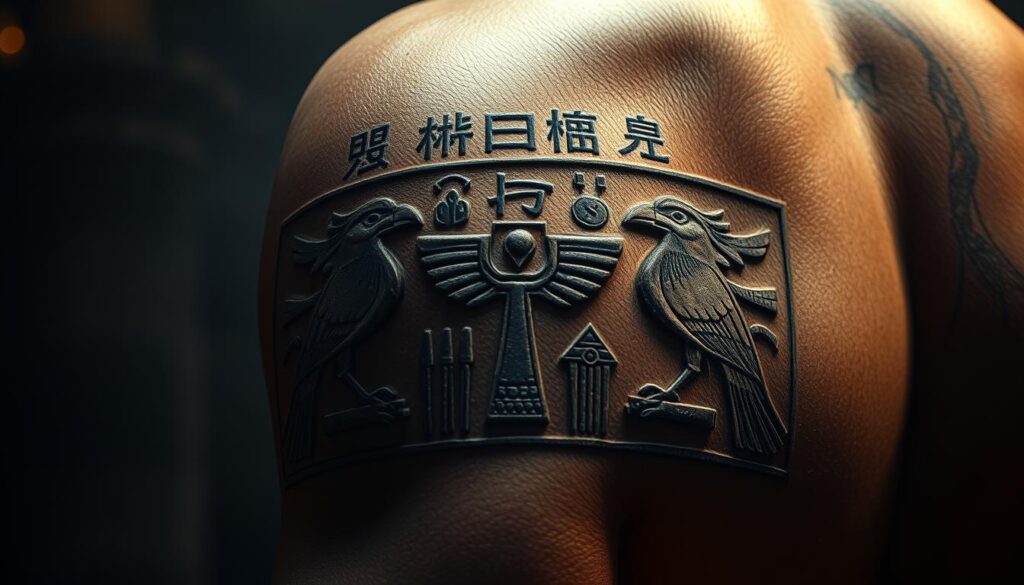
Ancient Egyptian hieroglyphics, once used for sacred texts, are now being inked onto skin as a form of personal and cultural expression. This ancient writing system, combining pictographic, logographic, and alphabetic elements, creates a rich visual language that is perfect for tattoo art.
Understanding the Language of Symbols
Egyptian hieroglyphics represent one of the world’s oldest writing systems, offering a unique blend of visual appeal and historical significance. Each hieroglyphic symbol can function as both a visual element and a carrier of specific meaning, allowing tattoo enthusiasts to incorporate authentic ancient Egyptian text into their body art. Understanding the actual meaning behind hieroglyphic symbols is crucial, as improper translation or arrangement can lead to unintended messages permanently inked on the skin.
Popular hieroglyphic tattoo choices include cartouches, which are oval frames containing names that can be personalized to spell out modern names using ancient Egyptian symbols. The linear nature of hieroglyphic writing makes it particularly suitable for tattoo placement along the spine, arms, or as bands around wrists or ankles.
Incorporating Hieroglyphics into Modern Designs
Modern tattoo artists have found creative ways to incorporate hieroglyphics into contemporary designs, blending them with other Egyptian symbols like the Eye of Horus or Ankh to create cohesive pieces. Some tattoo enthusiasts choose to incorporate actual ancient Egyptian texts or prayers into their designs, connecting them directly to the spiritual and cultural heritage of Ancient Egypt.
| Design Element | Symbolic Meaning | Tattoo Placement |
|---|---|---|
| Cartouche | Personalized name or message | Arm, wrist, or ankle |
| Eye of Horus | Protection and healing | Upper arm, shoulder, or back |
| Ankh | Eternal life | Chest, back, or shoulder |
The visual appeal of hieroglyphics lies in their geometric precision and artistic form, making them attractive even to those who may not fully understand their linguistic meaning. Contemporary interpretations of hieroglyphics in tattoo art range from strictly traditional reproductions to stylized versions that maintain the essence of ancient Egyptian art while incorporating modern aesthetic elements.
Best Placement Ideas for Egyptian Tattoos
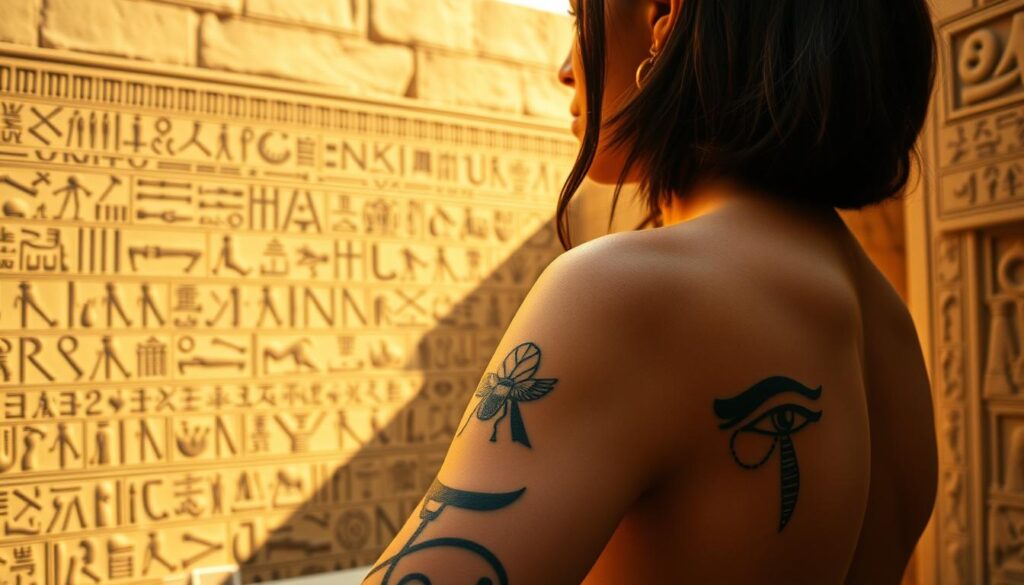
The strategic placement of Egyptian tattoos on the body has been a practice since ancient times, serving both aesthetic and protective purposes. The significance of placement is deeply rooted in the cultural and spiritual beliefs associated with these tattoos.
Traditional Placement in Ancient Egypt
In ancient Egypt, tattoos were strategically placed on women’s bodies for both aesthetic and protective purposes. Common locations included the abdomen, thighs, breasts, arms, and back. Archaeological evidence from tattooed mummies shows that placement often corresponded to the tattoo’s function—protective symbols were placed over vulnerable areas, while status markers were positioned to be visible.
Modern Placement Options and Their Significance
Today, individuals have the freedom to choose from a variety of placement options for their Egyptian tattoos, each carrying its own significance. The back provides an expansive canvas for elaborate Egyptian scenes or large-scale symbols, allowing for detailed storytelling. Wrists and forearms are ideal for smaller symbols like the Eye of Horus or Ankh, serving as daily reminders of their protective or spiritual significance.
| Body Part | Significance | Recommended Design |
|---|---|---|
| Back | Expansive canvas for detailed storytelling | Egyptian scenes, large-scale symbols |
| Wrist/Forearm | Daily reminder of protective or spiritual significance | Eye of Horus, Ankh |
| Chest | Powerful connection to symbols of love or protection | Protective symbols, sacred animals |
Size Considerations for Different Designs
The size of an Egyptian tattoo can significantly impact its overall appearance and the message it conveys. Larger designs like full Egyptian deities or temple scenes require more substantial canvas areas like the back, thigh, or chest. Simpler symbols can work beautifully as smaller pieces on wrists, fingers, or behind the ear.
Finding Inspiration for Your Egyptian Tattoo
Discovering the perfect Egyptian tattoo design can be a journey through ancient history and mystique. Egyptian tattoos are more than just aesthetically pleasing; they are a gateway to understanding a rich cultural heritage.
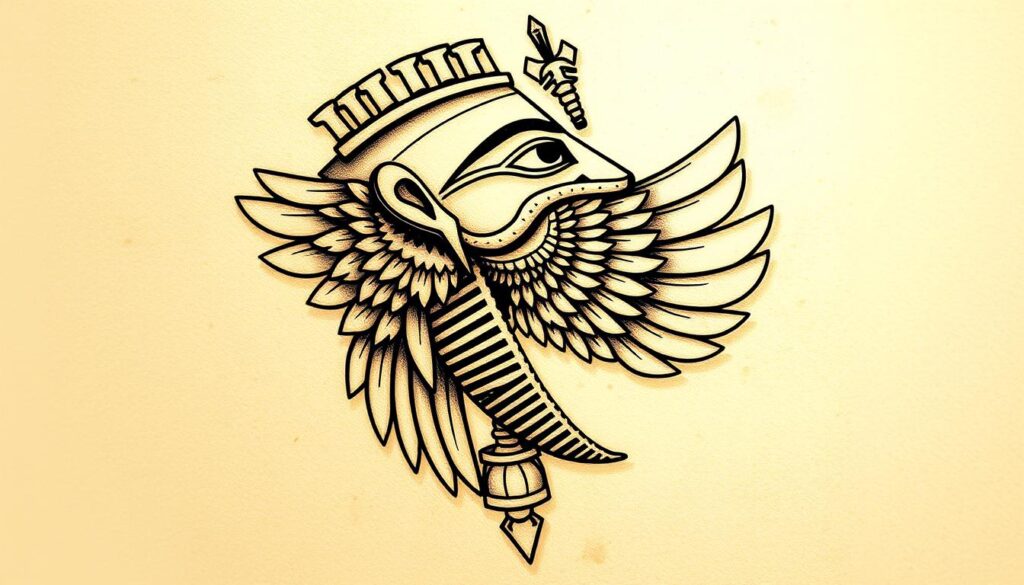
Researching Authentic Egyptian Art and Artifacts
To find authentic inspiration, one can explore museums with Egyptian collections, which offer a wealth of information on original artifacts and artistic styles. Additionally, delving into books and academic resources on Egyptian mythology and symbolism can provide deeper context for potential tattoo designs, helping you select symbols that resonate with your personal journey or values. You can explore more about beautiful tattoos on https://nailcutandink.com/beautiful-tattoos/.
Contemporary Artists Specializing in Egyptian Designs
Contemporary tattoo artists who specialize in Egyptian-inspired designs can offer unique perspectives on adapting ancient symbols for modern body art. They help maintain cultural integrity while ensuring the design is personalized to your attributes and life journey. Social media platforms like Instagram and Pinterest are also invaluable resources, showcasing countless variations of Egyptian tattoos and helping you visualize different symbols, placements, and styles on the skin.
Personalizing Ancient Symbols for Modern Expression
Personalizing ancient Egyptian symbols for your tattoo involves combining elements that hold special significance to you, creating a unique piece that honors both the ancient tradition and your individual story. Consider how color choices can enhance your Egyptian tattoo, with traditional black ink creating bold designs reminiscent of ancient wall paintings, and selective use of color highlighting specific elements. Your personal connection to certain aspects of Egyptian culture or mythology should guide your design choices, ensuring your tattoo has lasting significance beyond its aesthetic appeal.
Cultural Considerations When Getting an Egyptian Tattoo
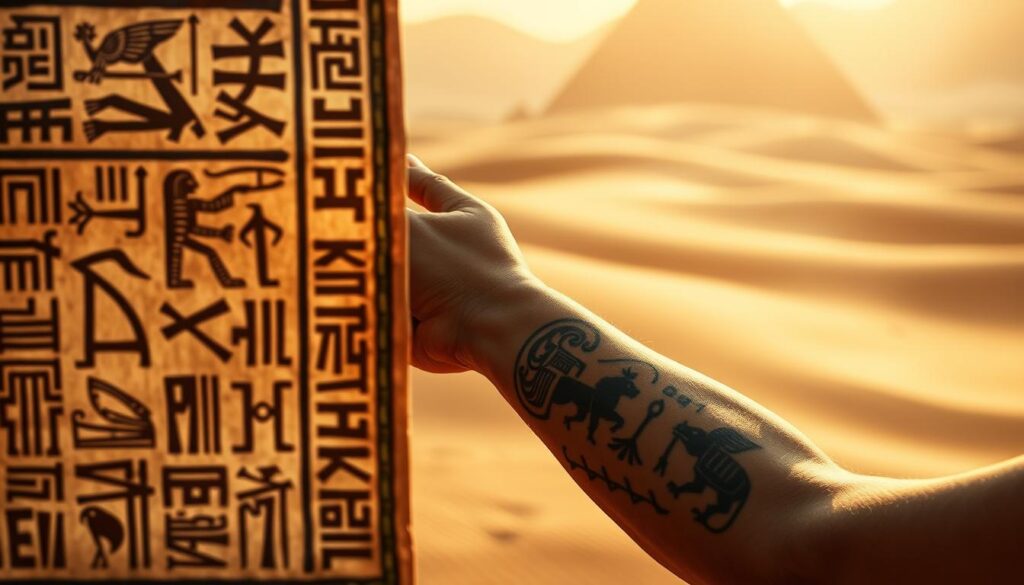
Before getting an Egyptian tattoo, it’s crucial to appreciate the historical and religious significance of the symbols involved. Egyptian tattoos are not just decorative; they are imbued with thousands of years of history and cultural significance.
Respecting the Historical and Religious Context
Egyptian symbols carry deep religious and cultural significance that extends beyond their aesthetic appeal. Understanding the historical context of these symbols is crucial to ensure that your tattoo honors rather than trivializes the rich cultural heritage from which these designs originate. Many Egyptian symbols were sacred religious icons, and appreciating their spiritual significance shows respect for the beliefs that shaped one of the world’s most enduring civilizations.
Consulting with experts or conducting thorough research about your chosen symbol’s meaning can prevent unintentional misrepresentation or inappropriate use of sacred imagery.
Avoiding Cultural Appropriation
Cultural appropriation concerns arise when symbols are adopted purely for their exotic appeal without proper understanding or respect for their cultural significance. Approaching Egyptian tattoo art with genuine appreciation involves learning about the culture, acknowledging the source of the symbols, and understanding their traditional meanings. It’s also important to consider how your tattoo might be perceived by people from these cultural backgrounds.
Finding ways to create a personal connection to your chosen symbols—through study, appreciation of Egyptian history, or meaningful life experiences—can transform your tattoo from mere decoration to thoughtful cultural engagement.
Conclusion: Embracing the Timeless Beauty of Egyptian Tattoos
Egyptian tattoos represent a timeless connection to one of history’s most fascinating civilizations, offering a unique blend of aesthetic beauty and profound meaning. These ancient designs have captivated people worldwide, serving as personal talismans that embody protection, strength, and spiritual significance.
The versatility of Egyptian imagery allows for endless creative possibilities, from minimalist hieroglyphic forms to elaborate scenes featuring gods and goddesses. Whether chosen for their protective qualities or sheer artistic beauty, Egyptian tattoos provide a meaningful way to connect with the past while expressing personal identity.
By approaching Egyptian tattoos with respect and understanding, individuals can honor the cultural heritage and symbolism behind these ancient designs. Ultimately, an Egyptian tattoo becomes a personal connection to history, a statement of identity, and a beautiful expression of humanity’s enduring fascination with the mysteries and magic of ancient Egypt.
